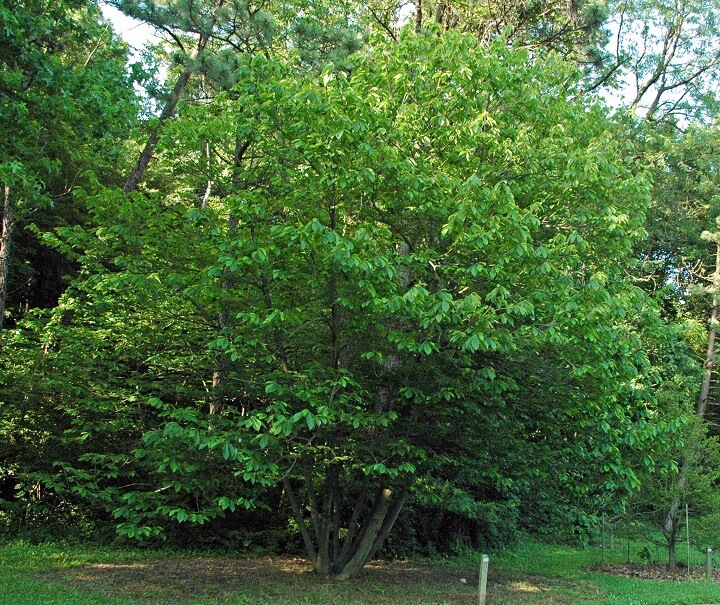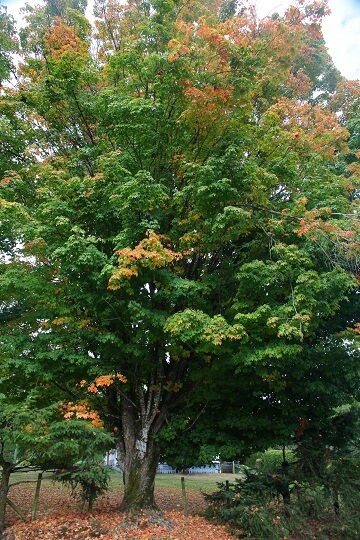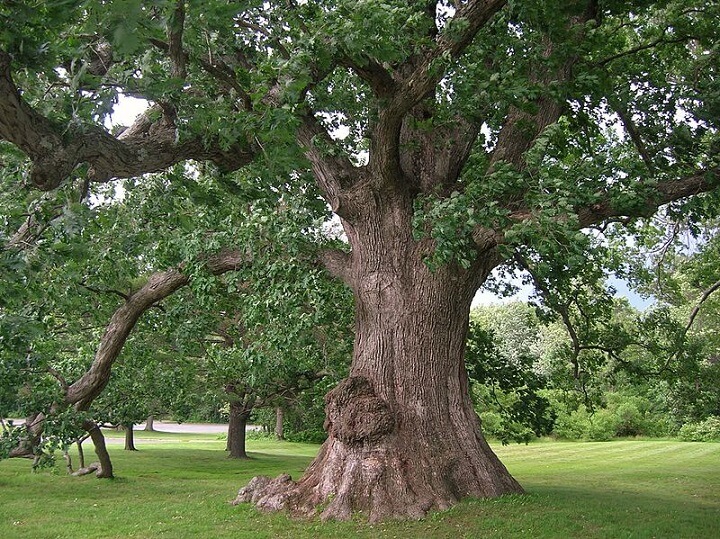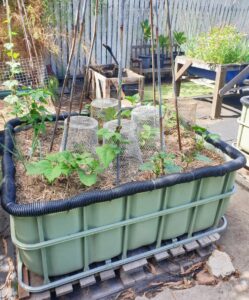Estimated reading time: 12 minutes
When it comes to preparedness, we often think about the items we need to purchase and stockpile. We may not consider what’s growing right on our own property or within a short distance. Trees not only provide oxygen, shade, and firewood, but they also offer many other benefits. Knowing about them could save your life in an emergency.
So, get out your tree identification guide if you need one, and learn about these seven trees every survivalist should know.
Want to save this post for later? Click Here to Pin It On Pinterest!
American Basswood

The American basswood (also called the American linden) is common to the eastern United States and often grows near creeks, streams, and ponds. Basswoods have large, toothed leaves. A leaf that is shaped like a tongue emerges at the base of the regular heart-shaped leaves on mature basswoods. Small, nut-like fruits hang from these “tongue” leaves during the summer months.
American Basswood Survival Tips:
- The inner fibers of basswood bark can be twisted into a sturdy rope.
- Basswood leaves are edible and are especially flavorful in the spring.
- The tree’s inner bark layer also is edible and has a sweet taste.
- Basswood is soft and is useful as friction firewood.
- It also is easy to carve.
Black Walnut

The Black Walnut, with its robust, dark bark and large, compound leaves, is a treasure trove for the survivalist. Native to the eastern United States, this tree is renowned for its valuable hardwood and nutritious nuts. Its round, green fruits contain a hard, brown nut inside, which is encased in a thick husk.
Black Walnut Survival Tips:
- Black Walnut nuts are rich in nutrients and provide essential fats and protein. Cracking the hard shell may require a rock or hammer, but the effort yields a tasty and calorie-dense reward.
- The husks of Black Walnut can be used to make a natural dye or stain, which could be useful for camouflage or marking items.
- The wood of the Black Walnut tree is incredibly strong and resistant to decay, making it ideal for constructing durable survival tools, shelters, or crafting bows and arrows.
- Caution should be exercised when collecting nuts or handling the leaves, as the tree produces juglone, a compound that can be toxic to other plants. This characteristic makes Black Walnut useful for creating a perimeter around a campsite to deter the growth of other vegetation.
- In a medicinal pinch, the inner bark of the Black Walnut tree can be brewed into a tea believed to have antiseptic and anti-parasitic properties, though this should be used with caution and knowledge of proper preparation.
Douglas Fir

The Douglas fir, prevalent in the Pacific Northwest, stands tall among its coniferous brethren. Recognizable by its thick, ridged bark and soft, flat needles that spiral around the branch, the Douglas fir is not a true fir but a member of the pine family. Its cones are distinctive, with bracts protruding from beneath the scales, resembling the back half of a mouse diving into hiding.
Douglas Fir Survival Tips:
- The inner bark of the Douglas fir is edible and can be dried and ground into flour or eaten raw in survival situations.
- Douglas fir needles can be brewed into a tea that is high in Vitamin C, much like the white pine. Simply gather a handful of green needles, chop them finely, and steep in boiling water for a few minutes.
- The resin from Douglas fir can seal small wounds and cuts as it has antiseptic properties. It can also be used as a waterproofing agent and adhesive.
- Young Douglas fir shoots in the spring are tender and edible, providing a refreshing citrus-like flavor.
Hickory

Hickory trees, with their hard, dense wood and distinctive shaggy bark on some species, are a valuable resource for survivalists. Found across the eastern United States, hickories produce nuts that are not only delicious but also packed with calories and nutrients.
Hickory Survival Tips:
- Hickory nuts can be eaten raw or roasted, providing essential fats and proteins. The shell may be tough, but the effort to crack it open is well rewarded with the rich, buttery nutmeat inside.
- The wood of the hickory tree is incredibly strong and can be used for making durable tools and handles for implements, as well as for bow-making.
- Hickory bark can be boiled to extract a syrup or used as a smoking agent for meat due to its aromatic properties.
- The strong, flexible wood is excellent for creating friction fires. A hickory bow drill can be a reliable method for fire-starting in survival situations.
Pawpaw Tree

Found in the wet woodlands of the eastern United States, the Pawpaw boasts a tasty mango-like fruit that ripens in mid to late September. However, the vitamin-rich fruit is only one of this tree’s benefits.
Pawpaw Survival Tips:
- Pawpaw bark strips easily and separates into long fibers of that can be twisted to make strong cordage.
- The tree’s wood is light and easy to carve. Some carvers compare pawpaw wood to balsa or yucca because it is light and porous. Additionally, pawpaw wood has a desirable bright yellow color and a straight grain.
Sugar Maple (and other maples)

Known for its large leaves that change into bright reds and oranges in the fall, the sugar maple offers many survival benefits. Not the least of these is its tasty syrup. Abundant in the eastern woodlands of North American, the sugar maple has leaves with five lobes and pointed tips. Young maple trees have smooth bark that has a silvery color.
Sugar Maple Survival Tips:
- The sap of the sugar maple, which runs in late winter and early spring is a natural energy drink rich in sugar and nutrients.
- Those seeds inside those distinctive helicopters are edible. All you need to do is boil them, remove the outer helicopter part and then eat them as is or add them to stir-fries or stews.
- Young spring maple leaves are also edible. You can boil them as you would other spring greens or add them to a salad.
White Birch

One of the easiest trees to identify, the white birch has white, papery bark that peels off in thin furls. It has small, oval-shaped and toothed leaves that have a pointed tip. The white birch (also called the paper birch) is native to the northern part of North America and is plentiful from Alaska to Maine.
White Birch Survival Tips:
- The paper-like bark works well as a firestarter.
- The sap is sweet and drinkable.
- You can make a wintergreen-flavored tea by brewing the bark or thin branches.
- The fungus that grows almost exclusively on the white birch is excellent tinder.
- When heated over a fire, the tar extracted from the bark make a strong natural adhesive.
- You can fashion containers for food or liquids from the bark.
White Pine (and other pines)
As an evergreen tree, the white pine has needle-like leaves and produces cones rather than flowers. White pines are native to northern central and northeastern North America.
White Pine Survival Tips:
- The inner layers of the white pine bark are edible.
- You can boil the needles to make a tea that is rich in Vitamin C. Steep a teaspoonful of chopped pine needles in a cup of hot water for 10 minutes.
- The tree’s resin is flammable and makes a useful fire starter when mixed with other tinder.
- Pine needles also make excellent fire fuel.
- You can mix the resin with charcoal to make a strong, waterproof glue.
- Edible pine nuts come from the cones.
- Pine needles and pine boughs can be used for bedding material.
- Pine boughs also do well as natural insulation in survival shelters.
- Surface roots of the white pine are pliable and durable and can be fashioned into ropes.
- Pine resin is an insect repellent. Collect some in a tin container and light it to keep bugs at bay.
- The bark of young pine branches is edible.
- Young male pine cones also are edible.
White Oak (and other oak trees)

The majestic white oak tree is native to eastern and central North America. It is easy to spot oak trees in mid- to late- summer because of their size and all the acorns they drop. Acorns are extremely useful in a survival situation. All acorns have bitter-tasting tannic acid, but it can be removed through a simple leaching process.
White oak acorns tend to have less tannic acid than other acorns, and their shell is harder and easier to remove than red acorns. While red oak trees have pointed leaf lobes, white oaks have leaf lobes that are rounded.
White Oak Survival Tips:
- After leaching out the tannic acid, you can grind acorns to make flour. Here is a video that shows this process for both white acorns and red oak acorns.
- Save the tannic acid to use as an antiseptic wash.
- Leached and ground acorns also can be used as a coffee substitute.
- Oakwood is firm and hard and is useful for many survival purposes, including shelter frameworks, ax handles and shovel sticks.
- Dried, white oak flowers are useful as tinder.
Willow Tree

You know there is a water source nearby if you see a willow tree. Although there are many varieties of this graceful tree, they all prefer moist areas. Willow leaves are narrow, plentiful and lance-shaped. Native to China, the willow grows throughout North America, Europe, and Asia in temperate regions that offer enough moisture and sunlight.
Willow Survival Tips:
- Willow bark contains a pain-relieving chemical called salicin. You can relieve headaches and inflammation by chewing on a few small green willow twigs and swallowing the juices.
- Willow bark peels away from the wood easily in the warmer months. You can use it to make a strong rope.
- Flexible young willow branches can be used to weave baskets.
- Dried willow makes an excellent fire starter.
Edible Bark
The inner bark of many trees — including Slippery Elm, most Pines, Black and Yellow Birch, Red and Black Spruce, Balsam Fir and Tamarack — is a nutritious wild food source.
In fact, early European explorers reported finding acres of trees that had been stripped of their bark – evidence that Native Americans commonly used bark as food and medicine. The Adirondack tribe, native to the mountains of upstate New York, means “bark eaters” in the Iroquois language.
The layer of choice to consume is called the cambium, and it lies right next to the wood. Most inner bark contains digestible starches, sugar, vitamins, minerals, and a large amount of fiber. Here are some examples of how tree bark is used as a food source and additive.
- Sassafras bark is used to make a traditional Southern tea and a root beer.
- Hickory nut tree bark can be stripped and boiled into a syrup that has an earthy, nutty taste.
- Birchbark provides a sweet, wintergreen flavor.
- In some parts of Scandinavia, pine bark is ground into a powder and used in Christmas cookies. Ponderosa pine bark smells like vanilla.
Here is a detailed video that shows how to harvest and prepare tree bark for consumption.
Tree Sap
Maples are not the only trees that are good for syrup. You can also use birch, hickory, and black walnut trees for their sap, which has a lower sugar concentration than natural maple syrup.
A Word Of Warning
Although most tree components are harmless, proper identification is critical since some have toxic chemicals within them. Also, be careful not to strip off an entire ring when harvesting inner bark. Tree bark should be considered an emergency food since it can stunt the growth of a tree or kill the tree. Here are a few helpful resources to guide you.
Resources:
Like this post? Don’t Forget to Pin It On Pinterest!


















